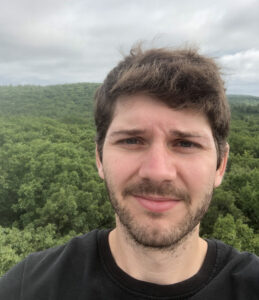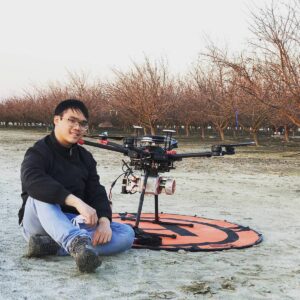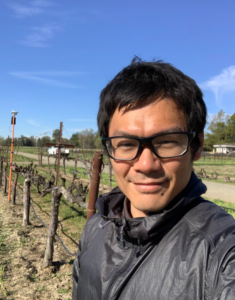Current methods for determining vineyard nutrient status are based on grapevine leaf sampling and analysis. Vineyard workers gather leaves from the vineyard at bloom or the start of ripening and send them to an analytical lab to measure nutrient concentrations. It can take weeks before the grower receives results from the lab, so it is hard for them to make timely management decisions.
The sensor development team is evaluating tools that can assess vineyard nutrient status more rapidly. An effective tool for growers must be easy to use across the entire vineyard and return practical information in real-time or quicker than standard methods. The team includes researchers from Washington State University, UC Davis, and the Rochester Institute of Technology (RIT) who work with the Plant Nutrition Team to understand how current technologies work within vineyard trials.
Changes in leaf nutrient levels can be measured in light wavelengths that are not visible or distinguishable to the human eye. These wavelengths can be measured in the vineyard by optical sensors placed on farm equipment (hyperspectral or multispectral camaras). The team is testing different sensors to track grapevine nutrient status during the growing season.
The specific objectives of this research are to…
- Determine the bandwidths that are most suitable for detecting nutrient issues.
- Identify the number of required wavelengths to measure.
- Determine the type of cameras to use (e.g., RGB cameras common on most smart phones and hyperspectral cameras) and conditions for optimal measurements.
To address these objectives, the team is generating aerial and ground-based images of leaves and vines within research trials in Washington, Oregon, California, New York, and Virginia. They are testing the effect of lighting and scale on the images and the data by taking photos under different conditions, such as time of day and under clear, sunny skies vs. cloudy skies. The images are then compared to nutrient concentrations from leaf sampling and analysis. These data are used to develop models that predict nutrient status from the sensor-generated images. Progress to date is outlined below, listed under the location where the trials took place.
California:
- Ground-based imaging of individual leaves
- Aerial hyperspectral and multispectral imaging of table grape vineyards
- Ground based multispectral imaging of raisin vineyards
- Aerial imaging of a commercial wine grape vineyard
Washington:
- Hyperspectral and 3D imaging of nitrogen fertilization trials in Sauvignon blanc, Syrah, and Concord.
- Hyperspectral and 3D imaging of potassium fertilization trials in Chardonnay
- Developed an adjustable shade on the sensor platform to block direct sunlight that was found to interfere with leaf readings at bloom.
New York:
- Unmanned Aerial System (drone)-based hyperspectral and multispectral images of Concord and Riesling blocks at three sites in upstate NY.
Publications from the team
- Assessing grapevine nutrient status from unmanned aerial system (UAS) Hyperspectral Imagery
- Nitrogen retrieval in grapevine (Vitis vinifera L.) leaves by hyperspectral sensing
- Impact of sun-view geometry on canopy spectral reflectance variability
Team Members
Researchers (see details here)
- Jan van Aardt, Rochester Institute of Technology
- Manoj Karkee, Washington State University
- Alireza Pourreza, University of California – Davis
Research Lab Staff

Atif Bilal Asad, PhD student, Washington State University
Atif has a BSc and MSc in Agricultural Engineering from the University of Agriculture, Faisalabad, Pakistan. He has three years of professional experience in Pakistan in banking, high-efficiency irrigation systems, and in the poultry sector. Atif is now working in the lab of Dr. Manoj Karkee at WSU, focusing on image analysis.

Rob Chancia, Postdoctoral Researcher, Rochester Institute of Technology
Dr. Rob Chancia is working in the Digital Imaging and Remote Sensing Laboratory at RIT under Dr. Jan van Aardt. His research explores how vineyard nutrient status influences spectral characteristics of the grapevine canopy, viewed in drone-based spectral imaging. He is responsible for all field-based application of remote sensing experiments in New York state vineyards. He also conducts image processing, data analysis, and nutrient mapping for the project.

Salik Khanal, Postdoctoral Research Associate, Washington State University
Dr. Khanal works in the lab of Dr. Manoj Karee at the Center for Precision and Automated Agricultural Systems (CPAAS) at WSU. His research focuses on machine vision, machine learning, and computer vision with an emphasis on applications in diverse sectors such as agriculture and industrial automation. Prior to joining Dr. Karee’s research group, he gained experience in industrial automation while working at a private company in Portugal. His current research efforts are in the advancement of hyperspectral sensor technology for the purpose of analyzing nutrient levels in vineyards.

Sirapoom Peanusaha, PhD student, UC Davis
Sirapoom is a team member in the Digital Agriculture Laboratory led by Dr. Alireza Pourreza. His research focuses on developing techniques for using the aerial multispectral and hyperspectral imagery to detect grape nutrient status.

Parastoo Farajpour, PhD student, UC Davis
Parastoo is working with the engineering team, specializing in identifying spectral characteristics of grape leaf canopies for nutrient status assessment. She is a part of the Digital Agriculture Lab at UC Davis, where they lead projects focused on developing decision support tools for specialty crops. Their research involves conducting nutrient status sensing experiments in different agricultural landscapes across California, contributing to advancements in sustainable crop management.

Yuto Kamiya, Visiting Researcher, University of California-Davis
Yuto is working in Alireza Pourreza’s lab. His research focuses on hyperspectral data analysis of specialty crops to identify the plant nutrient status. He has six years of industrial experience at Kubota, developing a telematics system for agriculture and construction equipment. He also worked on developing farm management applications for precision agriculture.
Past Team Members:
- Qin Zhang, Professor, Washington State University – retired, 9/2023
- Chenchen Kang, Penn State University – graduated 5/2023, Washington State University


